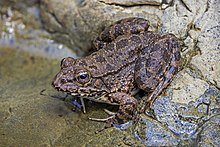True frog
| True frogs | |
|---|---|

| |
Cyprus water frog (Pelophylax cypriensis)
| |
| Scientific classification | |
| Domain: | Eukaryota |
| Kingdom: | Animalia |
| Phylum: | Chordata |
| Class: | Amphibia |
| Order: | Anura |
| Suborder: | Neobatrachia |
| Clade: | Ranoidea |
| Family: | Ranidae Rafinesque, 1814 |
| Synonyms | |
|
See text | |
True frogs is the
Typically, true frogs are smooth and moist-skinned, with large, powerful legs and extensively webbed feet. The true frogs vary greatly in size, ranging from small—such as the wood frog (Lithobates sylvatica)—to large.
Many of the true frogs are aquatic or live close to water. Most species lay their eggs in the water and go through a tadpole stage. However, as in most families of frogs, there is large variation of habitat within the family. There are also arboreal species of true frogs, and the family includes some of the very few amphibians that can live in brackish water.[1]
Evolution
The Ranidae are related to several other frog families that have Eurasian and Indian origins, including Rhacophoridae, Dicroglossidae, Nyctibatrachidae, Micrixalidae, and Ranixalidae. They are thought to be most closely related to the Indian-endemic Nyctibatrachidae, from which they diverged in the early Eocene. However, other studies recover a closer relationship with the Dicroglossidae.[2][3]
It was previously thought that the Ranidae and their closest relatives were of Gondwanan origins, having evolved on Insular India during the Cretaceous. They were then entirely restricted to the Indian subcontinent until the late Eocene, when India collided with Asia, allowing the Ranidae to colonize Eurasia and eventually the rest of the world.[3] However, more recent studies instead propose that the Ranidae originated in Eurasia, and their close relationship with India-endemic frog lineages is due to those lineages colonizing India from Eurasia during the Paleogene.[2][4]
Systematics
The subdivisions of the Ranidae are still a matter of dispute, although most are coming to an agreement. Several former
has now been split up and is much reduced in size.While too little of the vast diversity of true frogs has been subject to recent studies to say something definite, as of mid-2008, studies are going on, and several lineages are recognizable.[5][6][7]
- The genus Raninaelineage.
- monophyleticgroup.
- Odorrana and Rana plus some proposed minor genera (which probably ought to be included in the latter) form another group.
- A group including Huia in the strict sense and Meristogenys
- An ill-defined assemblage of
The following phylogeny of some genera was recovered by Che et al., 2007 using mitochondrial genes.[9]
Genera

Most of the subfamilies formerly included under Ranidae are now treated as separate families, leaving only Raninae remaining. The following genera are recognised in the family Ranidae:[10]
- Abavorana Oliver, Prendini, Kraus, and Raxworthy, 2015 (three species)
- Amnirana Dubois, 1992 (11 species)
- Amolops Cope, 1865 (80 species)
- Babina Thompson, 1912 (two species)
- Chalcorana Dubois, 1992 (nine species)
- Clinotarsus Mivart 1869 (three species)
- Glandirana Fei, Ye, and Huang, 1990 (six species)
- HuiaYang, 1991 (monotypic)
- Humerana Dubois, 1992 (four species)
- Hydrophylax Fitzinger, 1843 (four species)
- Hylarana Tschudi 1838 (four species)
- Indosylvirana Oliver, Prendini, Kraus, and Raxworthy, 2015 (13 species)
- Lithobates Fitzinger, 1843 (55 species)
- Meristogenys Yang, 1991 (13 species)
- Nidirana Dubois, 1992 (19 species)
- Odorrana Fei, Ye, and Huang, 1990 (64 species)
- Papurana Dubois, 1992 (19 species)
- Pelophylax Fitzinger 1843 (19 species)
- PseudoranaFei, Ye, and Huang, 1990 (monotypic)
- PteroranaKiyasetuo and Khare, 1986 (monotypic)
- Pulchrana Dubois, 1992 (18 species)
- Rana Linnaeus, 1758 (58 species)
- Sanguirana Dubois, 1992 (six species)
- Staurois Cope, 1865 (six species)
- Sumaterana Arifin, Smart, Hertwig, Smith, Iskandar, and Haas, 2018 (three species)
- Sylvirana Dubois, 1992 (12 species)
- Wijayarana Arifin, Chan, Smart, Hertwig, Smith, Iskandar, and Haas, 2021 (five species)
In 2023, Amphibian Species of the World tentatively synonymized Amnirana, Chalcorana, Humerana, Hydrophylax, Indosylvirana, Papurana, Pulchrana, and Sylvirana into Hylarana until significant taxonomic confusion surrounding the group could be cleared up.[11] These changes are not recognized by AmphibiaWeb.[12]
Incertae sedis
A number of taxa are placed in Ranidae incertae sedis, that is, their taxonomic status is too uncertain to allow more specific placement.
- "Hylarana" chitwanensis(Das, 1998)
- "Hylarana" garoensis(Boulenger, 1920)
- "Hylarana" latouchii(Boulenger, 1899)
- "Hylarana" margarianaAnderson, 1879
- "Hylarana" montivaga(Smith, 1921)
- "Hylarana" persimilis(Van Kampen, 1923)
See also
- trematodecommonly found in true frogs in North America
References
- J. Exp. Biol. 38 (3): 659–678. PDF fulltext
- ^ PMID 28673970.
- ^ PMID 16857652.
- S2CID 231519470.
- ^ Cai, Hong-xia; Che, Jing; Pang, Jun-feng; Zhao, Er-mi; Zhang, Ya-ping (2007): Paraphyly of Chinese Amolops (Anura, Ranidae) and phylogenetic position of the rare Chinese frog, Amolops tormotus. Zootaxa 1531: 49–55. PDF fulltext
- (HTML abstract)
- ^ Amphibian Species of the World 5.5, an Online Reference. "Hylarana Tschudi, 1838". American Museum of Natural History.
{{cite web}}: CS1 maint: numeric names: authors list (link) - PMID 17300963.
- ^ "Ranidae Batsch, 1796 | Amphibian Species of the World". 2023-05-28. Archived from the original on 2023-05-28. Retrieved 2023-08-07.
- ^ "Hylarana Tschudi, 1838". Amphibian Species of the World.
- ^ "AmphibiaWeb - Ranidae". amphibiaweb.org. Retrieved 2023-08-07.
- ISBN 1-877019-69-0
- Frost, Darrel R. (2006): Amphibian Species of the World Version 3 - Petropedetidae Noble, 1931. American Museum of Natural History, New York, USA. Retrieved 2006-AUG-05.
- Frost, Darrel R. et al. (2006): The amphibian tree of life. Bulletin of the American Museum of Natural History. Number 297. New York.
- Hillis, D.M.; Wilcox, T.P. (2005): Phylogeny of the New World true frogs (Rana).
- Pauly, Greg B.; Hillis, David M.; Cannatella, David C. (2009): Taxonomic freedom and the role of official lists of species names. Herpetologica 65: 115-128.
- Rafinesque, C.S. (2007): "Fine del prodromo d'erpetologia siciliana ". Specchio delle Scienze, o, Giornale Enciclopedico di Sicilia 2: 102-104. (Ranidae, new family). (in Italian).
